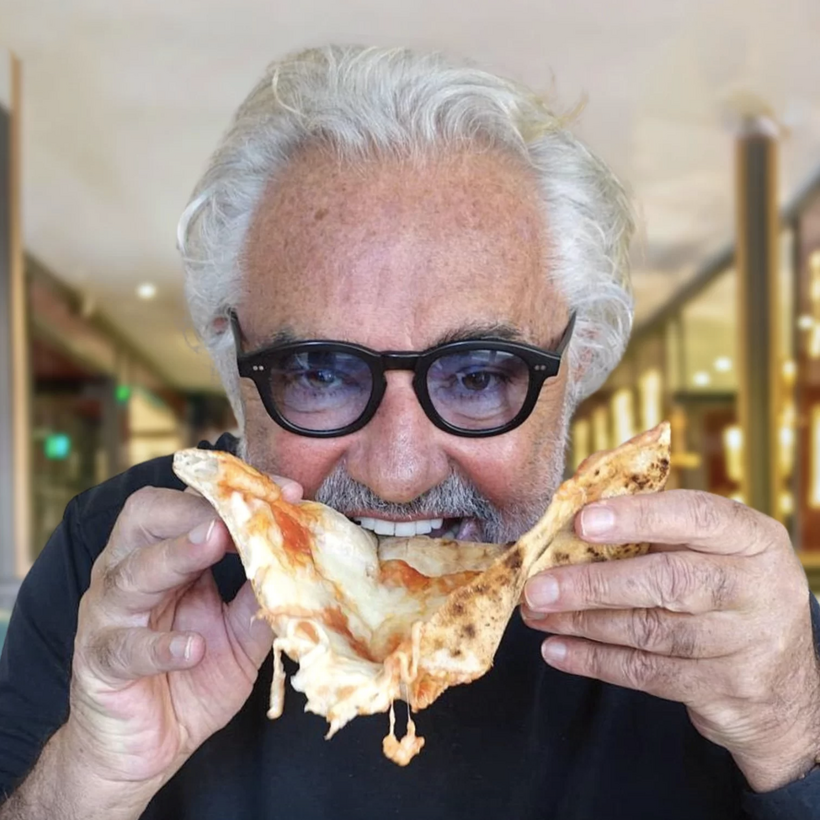On June 21, a crowd gathered in Via dei Tribunali, just outside the entrance to Gino e Toto Sorbillo, Naples’s most famous pizzeria. For miles around, people chanted, “Pizza popolare!,” Italian for “Pizza for the people!”
Gino Sorbillo himself was at the center of the hundreds of people, distributing pizza al portafoglio (smaller pizzas that you can fold in half and eat with your hands) for free. “In front of pizza, we are all the same,” he yelled as he held up a slice, “and everyone should be able to afford one!” The crowd cheered in approval.
This was no regular Tuesday in Naples, when locals and tourists line up for a taste of some of the world’s best pizza. Instead it was a day of protest—the people versus Flavio Briatore, owner of fancy pizzeria chain Crazy Pizza, which serves pies topped with truffles—marking an escalation in a conflict sparked a few days earlier.

On June 17, Briatore, a 72-year-old millionaire from Piedmont, took to Instagram from his gilded living room to speculate on the quality of low-priced pizza. “That thick chunk of bread with a lake of tomato in the middle.... Who knows what ingredients are in there?”
He ended the clip with some self-flattery. “The truth is, I’m a genius, and you, well … you just aren’t.” The comment did not go unnoticed among Neapolitans.
Crazy Pizza, Crazier Prices
Briatore’s thin-crust-pizza-and-signature-cocktail chain, operated under his Billionaire Life holding company, opened in Marylebone, London, in 2019, and has now expanded to serve upscale clientele in Riyadh, Monte Carlo, Porto Cervo, Milan, and Rome. A Doha location is scheduled to open in November.
A margherita pizza at Crazy Pizza costs 15 euros (the rough equivalent of $15). The Tartufo, a pie topped with bufala mozzarella and black truffle, goes for 49 euros. Add a sprinkle of pata negra (the best Spanish jamón) and the price jumps to 65 euros. There’s even a Pizza Bismark, named—if misspelled—after the German royal family, which is topped with ham and eggs.

The restaurants’ interiors are Cipriani-style—tan leather seats, black-and-white photographs (an obvious difference being that the photos are just purchased prints rather than chronicles of historic Harry’s Bar get-togethers). Guests flash designer bags and frequently opt for the Pizza Bismark, while pizzaioli theatrically juggle dough like circus performers. Loud techno music starts around 11 P.M.
“The truth is, I’m a genius, and you, well … you just aren’t.”
The scene-y spots stand in stark contrast to Naples’s pizzerias, low-key locales serving margherite and house wine, where the poorest citizens have historically collected pizza a credito during hard times.
Flavio Briatore has long been Italy’s poster champagne man. After being accused of multiple counts of fraud in the 80s, he did a stint in exile in the U.S. Virgin Islands. In the early 90s, he returned to Italy as manager of Benetton’s Formula One team, where he discovered and mentored a young Michael Schumacher. In 2008, he was accused of race-fixing and ousted from the team.

Turbulent romances with Naomi Campbell (whom he notoriously kicked off his yacht in 2001) and, later, Heidi Klum have made him a tabloid regular. In 2004, he was rumored to have fathered a daughter, Leni, with Klum. Briatore refused taking a paternity test. Leni, who looks eerily like Briatore, was adopted by Klum’s former husband Seal in 2009. “I obviously didn’t have a day-to-day relationship with her,” Briatore told Elle in April, “but that doesn’t mean I love her any less.” More relationships, including with a 20-year-old student, have followed.
Briatore owns the Cipriani franchise in Monte Carlo. He also owns and operates the ostentatious Sumosan Twiga, an Italian-Asian fusion restaurant in London, as well as the Twiga beach clubs in Forte dei Marmi and Monte Carlo. He started a clothing line, Billionaire couture, eventually selling it to Philipp Plein. Then there are his Billionaire nightclubs, in Porto Cervo, Riyadh, and Dubai, where models and finance executives meet up to drink Dom Pérignon.
Crazy Pizza has “the same vibe as his nightclubs,” one person tells me. “Football players meet chicks who wear heels to eat a pizza.”
A few days after Sorbillo’s “pizza for the people” campaign made the national press, Sorbillo and Briatore announced a cease-fire on the Italian TV show Porta a Porta. But the handshake did little to quell a nationwide debate about Italy’s favorite food.
“In front of pizza, we are all the same, and everyone should be able to afford one!”
Newspapers have devoted essays to “provocative pizza,” “aristocratic pizza,” and “caviar pizza.” The news channel TG24 compiled a list of the world’s most expensive pizzas. (The winner, made with nearly an ounce of edible gold leaf, was sold to a YouTuber by a chef in the U.S. for $70,000.)

At the restaurant L’Angolo di Beppe, outside Lecce, Apulia, a dig to Briatore takes the form of a namesake pizza recently added to the menu. The price tag for the pie, a plain margherita with a basil B for “Briatore” on it, is 49 to 99 euros, depending on how much cash you want to flash.
The price of Briatore’s pies isn’t the only thing Italians are taking issue with. While Americans’ more-is-more approach readily extends to food, putting random expensive toppings on a margherita is considered blasphemous in Italy, a perversion of a sacrosanct dish that hasn’t changed much since the ambitious chef Raffaele Esposito presented it to Queen Margherita of Savoy in 1889.
“You just don’t do that,” said the media personality Roberto Parodi, reacting to Briatore’s pata negra pizza.

Tradition is not something Briatore seems to care much for. “He makes his pizzas in an electric oven,” a waiter at Naples’s Concettina ai Tre Santi tells me. “Tell me, how can someone do that?”
Anger against Briatore is widespread and, like everything in Italy, passionate. Street vendors in Naples’s Spanish Quarter, known for selling miniature replicas of Nativity scenes, have even started making papier-mâché statues of Briatore, clad with his signature sunglasses and surrounded by miniature pies—an elaborate presa per il culo, or “f*ck you.”
“My problem is, it’s just not real pizza,” one Neapolitan tells me. “We don’t want people to think that’s what real pizza is. It’s an offense to who we are.”
Elena Clavarino is an Associate Editor for Air Mail


